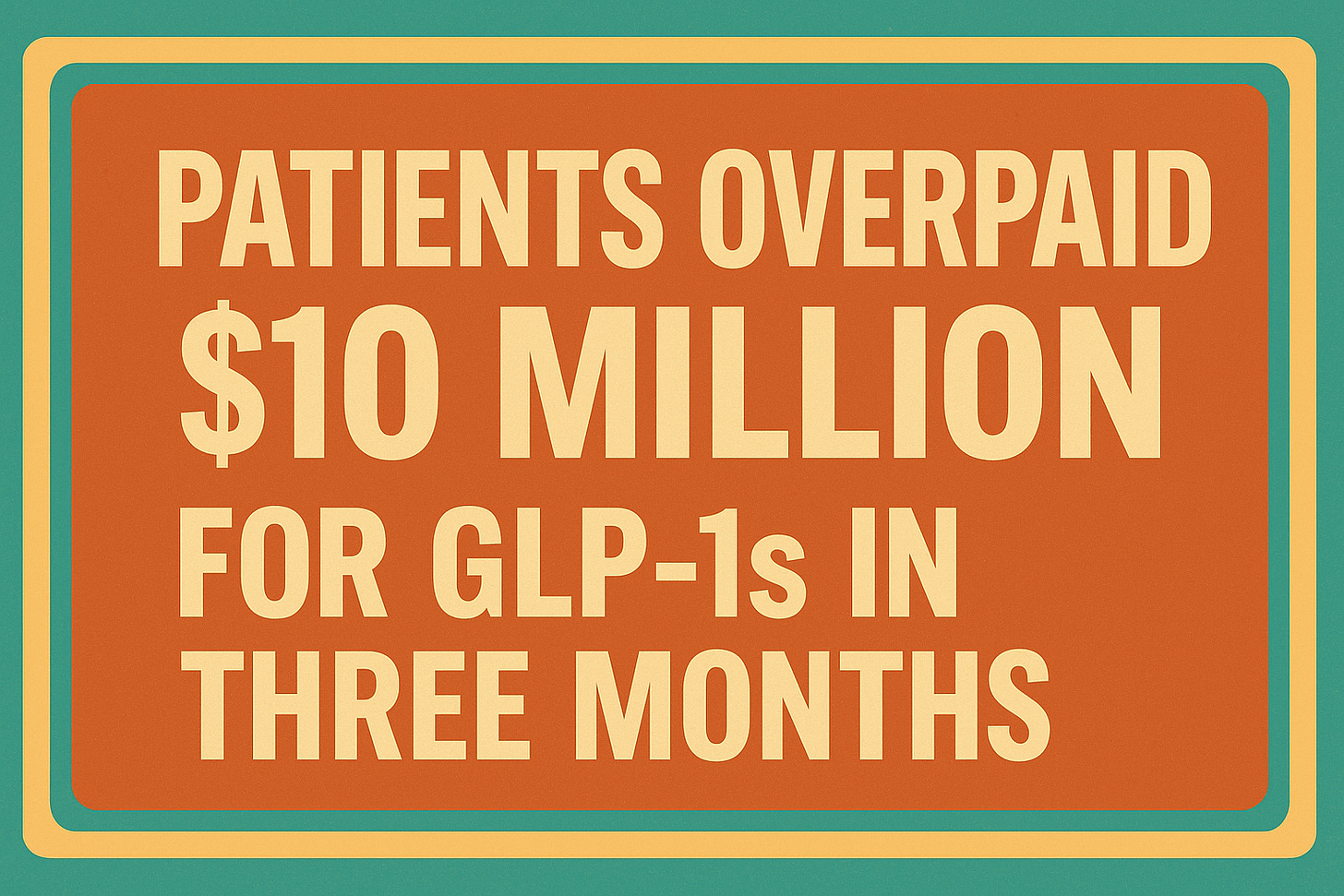Patients Threw Away $10 Million on GLP-1s in Just Three Months
How 92% of GLP-1 prescriptions could have cost less—and why no one’s talking about it.
Here's a number that'll make your head spin: patients overpaid $10.2 million for GLP-1 medications in the first three months of 2025 alone.
I wish I was making this up.
A new study from DoseSpot, an e-prescribing platform, analyzed over 100,000 prescriptions for drugs like Ozempic, Mounjaro, and Zepbound. What they found was pretty depressing—92% of those prescriptions could have been filled for less money. Way less money.
So how did we end up here? And more importantly, why does this keep happening?
Having Insurance Doesn't Mean You're Protected
Here's what surprised me most: 94% of the patients in this study had commercial insurance. You'd think that would help, right? Wrong.
Even with insurance, people are getting slammed with high costs because their plans either don't cover GLP-1s at all, or they make you jump through hoops like prior authorization and step therapy. It's like your insurance company is actively trying to make your life harder.
And if you're one of the 6% without insurance? Good luck. You're looking at potentially thousands of dollars a month out of pocket.
The crazy part is that most of that $10 million could have been saved with manufacturer discount programs and pharmacy coupons that already exist. The problem isn't that the savings aren't there—it's that nobody's talking about them.
The Conversation That's Not Happening
Josh Weiner, DoseSpot's CEO, said something that stuck with me: "Patients need to do their homework." And he's right, but that feels backwards, doesn't it?
Think about the last time you went to the doctor. Did they sit you down and explain all the ways you could save money on your prescription? Did they walk you through manufacturer coupons or alternative pharmacies? Probably not.
Most doctors are either too busy, don't know the details themselves, or assume someone else will handle it. And most patients don't even know they should be asking these questions.
This isn't really about GLP-1s. This is about a healthcare system that's fundamentally broken when it comes to helping people afford their medications.
The Numbers Tell a Story
Right now, about 1 in 8 American adults—that's 32.8 million people—are taking a GLP-1. Nearly half of them are using it for weight loss, not diabetes.
But here's the kicker: fewer than 20% of employer health plans actually cover these drugs for weight loss. So even as demand explodes and we see more evidence that these medications can be life-changing for people's metabolic health, insurance coverage is lagging way behind.
That leaves millions of people stuck between wanting to improve their health and being able to afford it.
Why People Give Up
Want to know something that'll break your heart? Only about half of people who start a GLP-1 are still taking it after six months. By the one-year mark, that drops to just one in three.
Cost is a huge reason people quit. We're not just talking about people giving up on weight loss—we're talking about people walking away from medications that could genuinely transform their health because they can't afford to stay on them.
And with compounded versions getting squeezed out of the market, finding affordable options is only getting harder.
What This Really Means
This study isn't just about $10 million in wasted money, though that's obviously infuriating. It's about what happens when our healthcare system makes it nearly impossible for people to afford medications that could change their lives.
When people can't afford to stay on their medications, everyone loses. Patients don't get better. The healthcare system deals with more complications down the road. And we all keep having the same frustrating conversations about drug pricing.
Something has to change. Whether that's providers getting better at discussing cost-saving options, patients getting more aggressive about asking questions, or policymakers finally doing something meaningful about drug pricing—I don't really care. But this can't continue.
Because $10 million in overpayments in three months isn't just a statistic. It's 100,000+ people who got burned by a system that should be helping them, not bankrupting them.
What You Can Do
If you're on a GLP-1 or thinking about starting one, don't assume your doctor or pharmacist is going to tell you about every way to save money. Ask about:
Manufacturer discount programs (most drug companies offer them)
Pharmacy coupons and discount cards
Different pharmacies with better pricing
Patient assistance programs if you qualify
It sucks that you have to become your own advocate, but right now, that's the reality.
Sources:
Connect
Join GLP-1 Real Talk on Circle





It’s call let’s take advantage of obese people with a chronic issue after we poison you with plastics and medicine that make you gain weight . Then we flip the switch and call you names . The drug take 5 dollars to make a month and that is with commission . The law causing pharmacy benefit managers to be more transparent is fought every time . They don’t want you to know the mark up . They screw is all
Me. I overpaid.